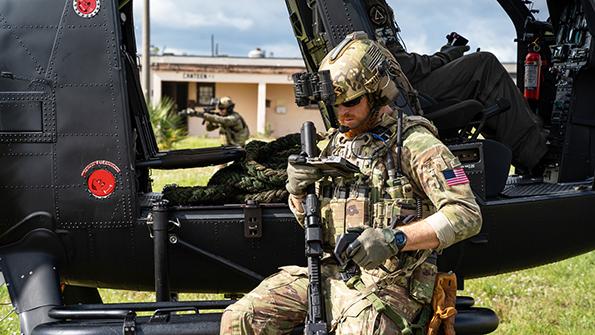
AeroVironment wants to use Tomahawk Robotic’s technology to create a common operational picture.
The prevailing wisdom is that the future of warfare is robotic. Yet, as things stand, behind each robot is a human with a controller. This 1-to-1 ratio is unwieldy. It limits how many uncrewed systems can be fielded on the battlefield and creates headaches for soldiers who find themselves juggling multiple controllers and robotic systems at once.
AeroVironment, a maker of small uncrewed air vehicles (UAV), loitering munitions and ground robots, sees an opportunity in this. The company closed its acquisition of Tomahawk Robotics, a developer of software and hardware to control multiple tactical uncrewed air and ground vehicles at once, for $120 million on Sept. 18.
- Tomahawk Robotics tablet can operate many uncrewed systems from one device
- Edge computing to play prominent role in future warfare
“We want one controller, one ground control station, one user interface that allows multiple devices to be operated and managed and useful for the soldier,” AeroVironment CEO Wahid Nawabi says. “Tomahawk is exactly that. That’s what they provide.”
Tomahawk, founded in 2018, makes a customized, ruggedized tablet that runs the Android Team Awareness Kit (ATAK) app and its own Kinesis software, which enables the control of multiple uncrewed systems at once, including air and ground vehicles. Kinesis also handles mission planning and data sharing, such as video feeds, with other ATAK tablets.
Tomahawk’s Kinesis control system was integrated in 2022 into AeroVironment’s small UAV family, including fixed-wing drones Raven B and Puma 3 AE. It is also used for ground robots made by companies such as Ghost Robotics and Boston Dynamics, as well as small drones made by Skydio, Parrot and Anduril.
The Defense Department is trying to find new ways for robotic vehicles to help soldiers. As the number of uncrewed systems on the battlefield grows, the Pentagon has been vocal about wanting autonomy software and networks, such as its Joint All-Domain Command and Control concept, to make managing multiple systems easier.
AeroVironment is betting on Tomahawk and the idea that at the tactical level “smaller, unmanned systems and loitering munitions are going to play an even bigger role because of the conflict in Ukraine [and] what it demonstrated,” Nawabi says.
The company sees Tomahawk’s technology providing small forces at the edge of the battlefield a common operational picture and allowing them access to information to “make decisions and take actions much faster and quicker, and get an advantage,” Nawabi says.
Tomahawk also makes wearable radio links for transmitting video and voice data plus wearable edge computers, which are small devices for analyzing videos, making 2D or 3D maps, and conducting electronic warfare and signal intelligence. That data, which may be collected by nearby tactical UAVs or uncrewed ground vehicles, is sometimes too voluminous to send back to a command-and-control center for processing, and so instead the data is handled at the edge of the battlefield.
Ultimately, AeroVironment envisions offloading decision-making to the uncrewed systems themselves via various forms of autonomy. Nawabi points to the company’s visual-based navigation system for the Puma AE fixed-wing drone, which uses visual inertial odometry to determine its location in areas where GPS might be jammed, spoofed or disrupted.
“That’s going to be table stakes across all of our platforms,” he says. “That’s the future we’re working toward.”
Systems like that might allow the company’s loitering munitions, such as the anti-armor Switchblade 600, to play a role in hunting enemy ships. For example, without a radio link or GPS signal, the loitering munition could be programmed to autonomously identify and attack particular ship models of China’s People’s Liberation Army Navy, Nawabi says. Such an autonomous system would rely on its edge in computing capacity: the onboard computing power on the loitering munition.
“That information is stored on [the UAV’s] memory. You have a map of the area—you have no GPS, no comms—you’re going to go out there and you’re going to do all the computing on board,” Nawabi says. “Edge computing, especially at low SWAP—low size, weight and power—is really hard. I am dealing with watts of power, not kilowatts of power.”
Loitering munitions may be able to have an outsized impact on the battlefield if they can be coordinated by the dozens to attack and cripple expensive military hardware, such as aircraft carriers, he adds.
“Even if only half of them make it, they can do a lot of damage,” Nawabi says. “That’s the future that we’re building, and Tomahawk Robotics is going to be a critical piece of that puzzle to allow us to achieve that long term.”





